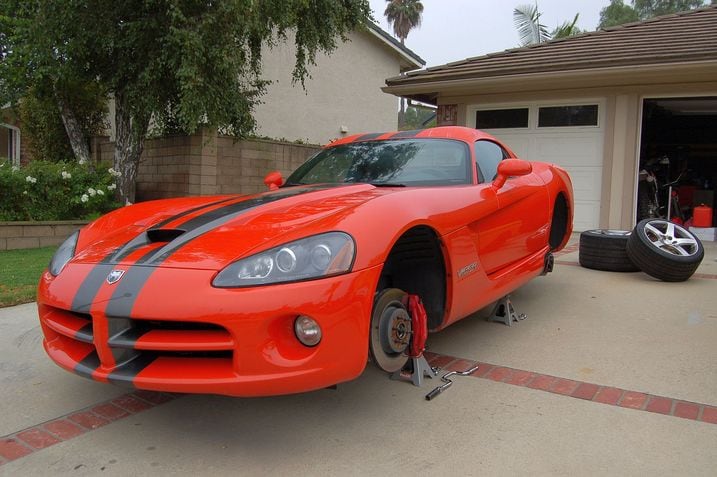
At first I thought my floor jack wasn't going to be sufficiently low enough to slide under our 2009 Dodge Viper SRT-10. Then I imagined the side-pipes would cause trouble. Thankfully, I was dead wrong on both counts.
Let's have a look at this beast.

Considering the Viper's mission, it's not surprising that its front suspension is a straightforward double a-arm setup with a canted coil-over shock running through the middle of it all. The upper and lower arms are made of aluminum.

The Viper's steering rack (yellow) sits ahead of the front axle centerline, where it should be, and its pinion axis is reclined so that it points almost directly at the driver. Any u-joints in the steering shaft will therefore have a small angle of incidence, and that helps steering precision.
In other unrelated news, a functional brake duct directs cooling air right at the brake rotor.

This is the left-front lower control arm, but it could just as easily be a right-front one, because they're interchangeable. All you have to do to prep one for the other side is move the trio of lower shock-mount bolts (yellow) and the stabilizer bar drop-link (green) to the waiting holes that sit opposite.
Meanwhile, the presence of a Zerk fitting (white) means you get to re-grease your ball joints, a lost art.
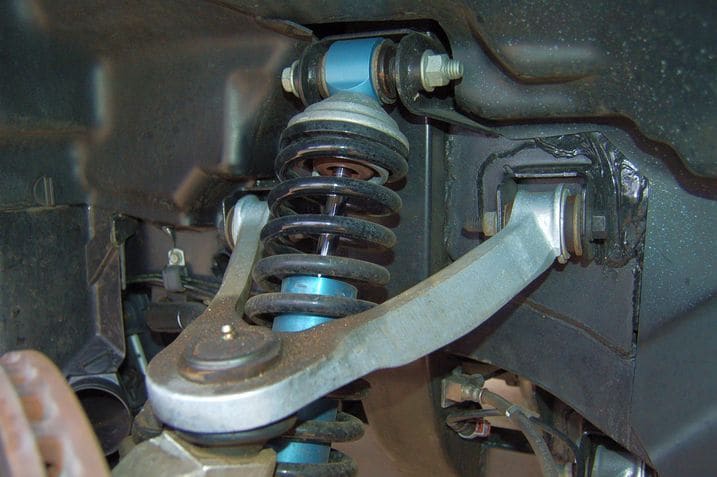
The Viper's upper arms also look very much the same side-to-side, but there's nothing bolted to them that needs to be reconfigured. What's more interesting is the hand-fabricated look of the frame and the brackets. Yeah, this is a low-volume sports car.
And look, there's another ball joint with a Zerk fitting.

In case you're wondering why three bolts are involved with the lower shock mount, take a look at this bracket. The coil-over shock itself is in fact held in place with a single bolt.
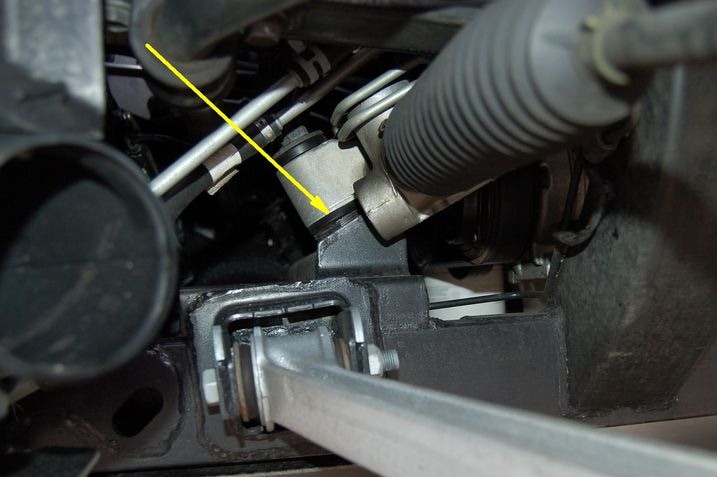
Here's a close-up of the steering rack mount. Like every other major suspension piece on this car, it is bolted directly to the frame. There are no sub-frames to ease final assembly by allowing major suspension subassemblies to be put together off the car and installed as a unit.
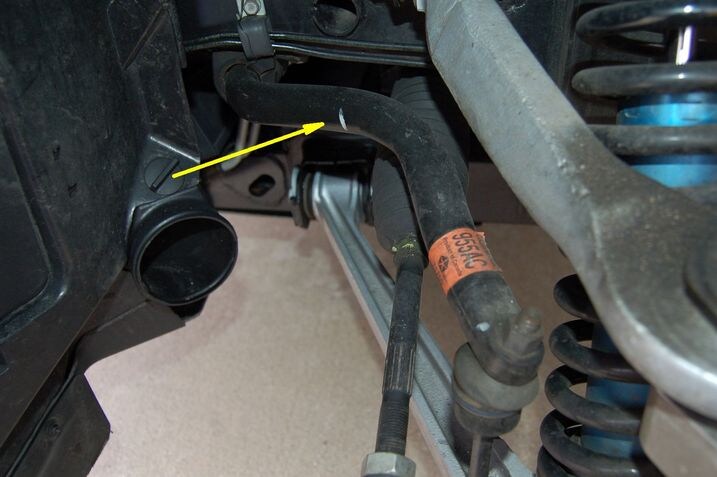
The forward-mounted front stabilizer bar is simple and straightforward.
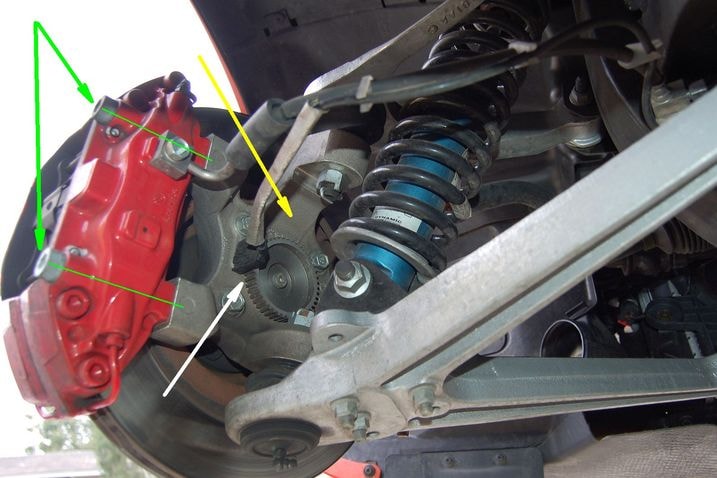
Aluminum is also the material of choice for the Viper's front suspension knuckles (yellow). That sawtooth degree wheel provides myriad sharp edges for the ABS sensor (white) to monitor in order to forecast the onset of brake lockup.
The front brakes in question feature massive 4-piston fixed Brembo calipers. They mount to the knuckle with two large Allen-head bolts.
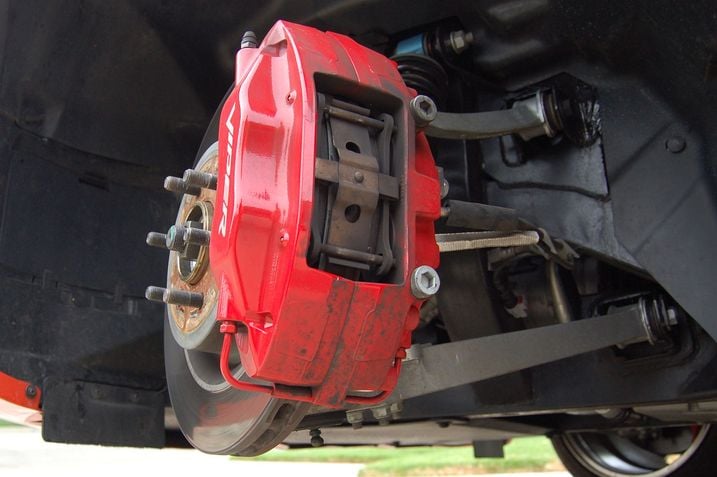
Release those two slender pins and the brake pads will slide easily out of the caliper's "window". The brake rotors they rub against are one-piece 14-inch ventilated cast iron units.
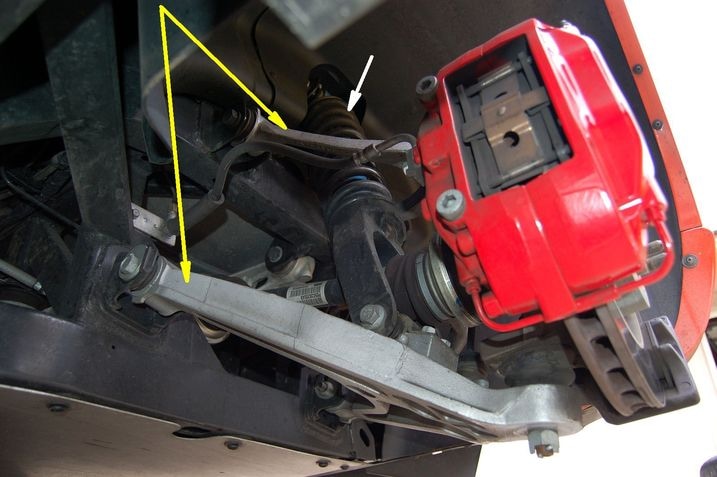
Moving to the back, we see another pair of aluminum a-arms (yellow) and another reclined coil-over shock (white).
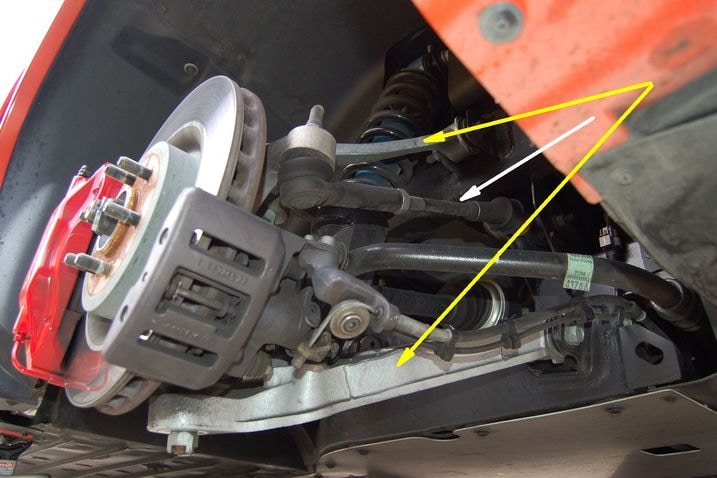
This view from the rear shows the dual aluminum a-arms again (yellow), but the important thing to note here is the toe link (white), the piece that keeps the rear wheels pointed straight ahead. It's got a jamb nut midway along its length. Loosening it allows one to twirl the link and make it longer or shorter to adjust static toe-in.
Up to this point, the Miata and the Viper share a surprisingly similar front and rear suspension philosophy, albeit on different economic, horse-powerific, and aluminum-intensive scales. The Viper's rear lower control arm is a true a-arm, with a single outer ball joint. This mutli-directional pivot is why the Viper has a stand-alone toe-link like we see here.
On a Miata, the rear lower arm is h-shaped, with two outer pivots that can only rotate about a single axis. Toe-control is built-in to the Miata's arrangement, but it makes toe-in a pain to adjust (and keep adjusted) because one has to monkey with eccentrics on both inner pivots of the lower arm to adjust camber and toe simultaneously. The Viper's rear setup is far easier to deal with.
Don't worry about those brakes (plural) just yet. We'll get to them later.
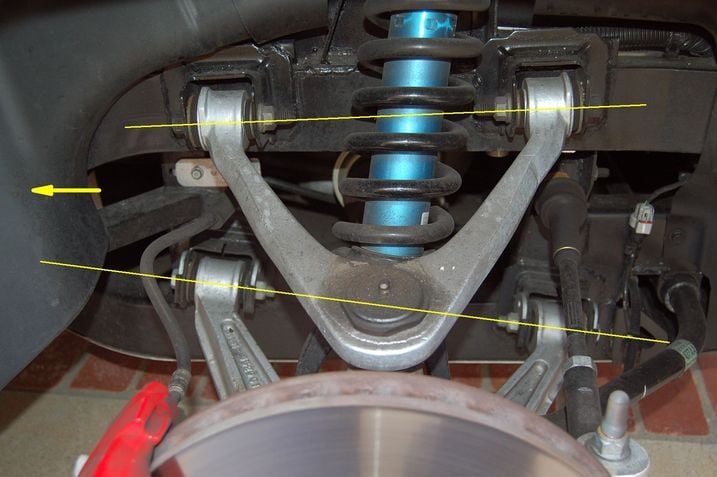
The inclined pivot axis of the Viper's rear lower control arm is a sure sign of a healthy dose of anti-squat geometry. It's much needed because, with 600 horsepower on tap, the Viper's squat potential is quite high. In turn, the spring and shock are reclined a similar number of degrees because they attach to the lower arm and move with it. The idea is to keep things nice and perpendicular so there's no binding as the suspension moves.
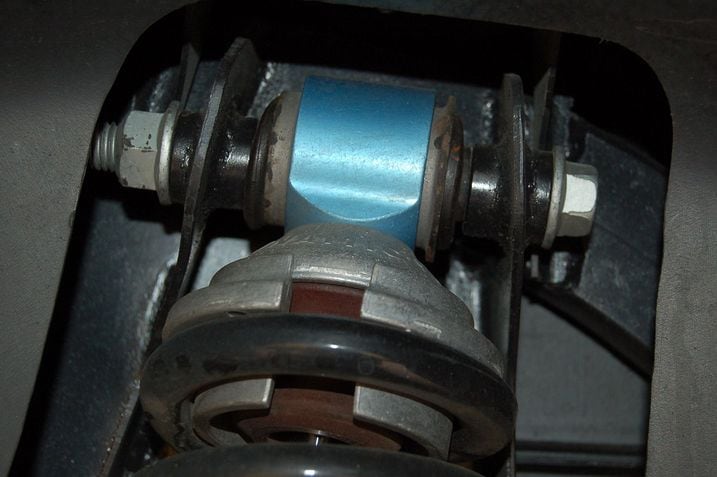
Here's an up-close view of the upper shock mounting bracket. It has the hand-fabricated look of a tube-frame race car.
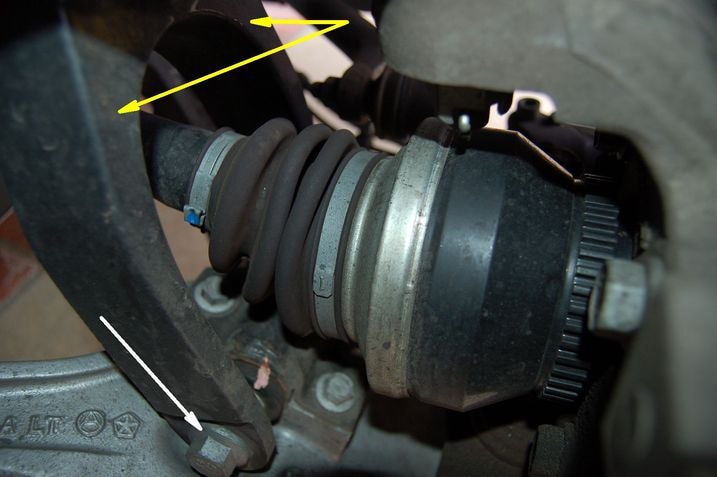
Of course there's a drive axle back here, so the lower end of the shock mounts to a fork that splits (yellow) and goes 'round either side of it. At the bottom, a single bolt (white) spans the fork and connects the shock to the lower a-arm.
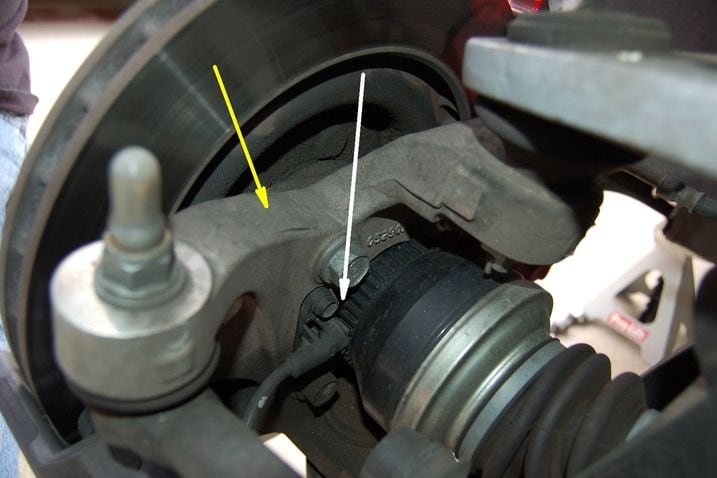
Like the front, aluminum is used for the rear knuckle (yellow). Also like the front, the ABS degree wheel and sensor are naked and easy to see (and service).
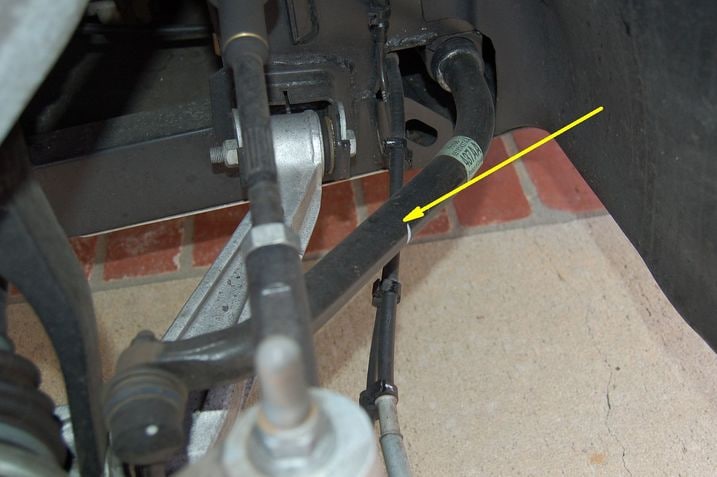
Pre-2008 Vipers were tuned to understeer quite a bit, and even then they were known to swap ends on acceleration. But some important changes were introduced in 2008.
First, the run-flat tires were scrapped in favor of "normal" Michelin Pilot Cup PS2 rubber. The run-flats, with their hyper-stiff run-flat sidewalls, had been skittish due to their inability to conform to rippled pavement and their intolerance for very much negative camber. Extra understeer was therefore dialed into the suspension calibration. Going to normal rubber gave the tires the ability to conform to the surface better and allowed an increase in static negative camber, both of which improved mechanical grip and stabilized the rear of the car. Complimentary changes were made to the shock valving.
These seemingly small tweaks also allowed the stabilizer bar's stiffness to be increased, which in turn reduced the base level of understeer and made the car more neutral. But in doing that the rear stabilizer bar diameter hasn't been increased at all. Pre-2008 Vipers used a hollow rear bar, but this one is solid, straight through. OK, it weighs a couple of pounds more, but I'll take it.
I've actually driven one of these at Virginia International Raceway (VIR) in anger and found it to be well-balanced and stable, like a big Miata but with 600 horsepower. (Road racers will understand that as a compliment). A 2008-plus Viper like this one, on a suitably open racetrack, at least, is not a ham-fisted machine at all.
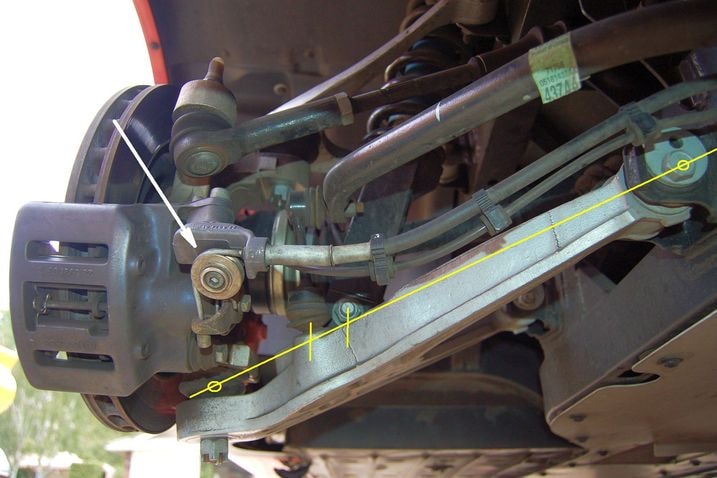
By now you should be familiar with my motion-ratio analysis of the lower control arm. The coil-over spring and shock are of course co-linear, so they'll share the same arm ratio, somewhere in the neighborhood of 0.60-to-1. They'd truly be at 0.60-to-1 if they stood straight up and down, but the actual motion ratio will be somewhat lower because of their reclined axis. We can't really tell what the overall ratio from here because the lower control arm is hanging at full droop. The angles that matter are the ones that exist when the car is sitting on the ground.
Meanwhile, our trusty stabilizer mounts a little closer to the outer ball joint, so its motion ratio is closer to 0.70-to-1.
The first of the Viper's two rear brake calipers is a mechanical parking brake. The cable runs just above the lower arm until a pulley (white) turns it 90 degrees just before it connects to the actuating lever.
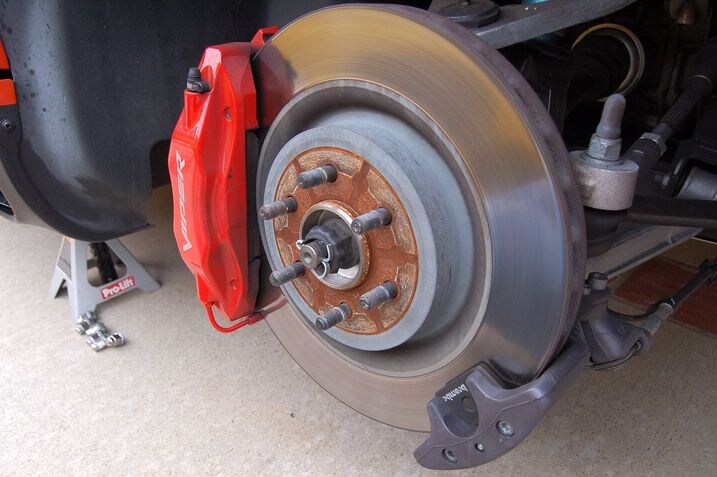
If you look closely at the parking brake caliper's pads, you'll see that it, too, is made by Brembo. Meanwhile, the main working rear caliper is a 4-piston fixed caliper, just like the front.
But it's not exactly like the front one, which is made up of pairs of pistons measuring 44 and 40mm in diameter. The piston pairs in this rear caliper are sized a bit smaller at 42 and 38mm. (The leading pair of pistons are the smaller ones, the trailing pair are larger. This difference equalizes the clamping force across the length of the pad.)
On the other hand, that 14-by-1.26-inch one-piece ventilated cast iron rotor is exactly the same size as the one in front, which makes them interchangeable. Much like the front a-arms, racers only need to carry one kind of spare.

And who could forget the Viper's all-important Michelin Pilot Sport PS2 tires. Of course they're massive; the fronts are 275/35ZR18 and the rear ones measure 345/30ZR19. But the wheel and tire assemblies, at 51.5 and 64.0 pounds respectively, aren't as heavy as you might think because the wheels are lightweight forged aluminum.
Our 2009 Dodge Viper is a pretty stout track car, especially if the track is large-scale and flowing. The reasons why become clearer when you peer under the skin: the Viper is more of a space-frame track car that's been adapted to street use than the other way around. It has the look of something that was dreamt up by a bunch of folks who spend their weekends with their own play-cars at their local racetrack.
Dan Edmunds, Director of Vehicle Testing @ 15,300 miles
